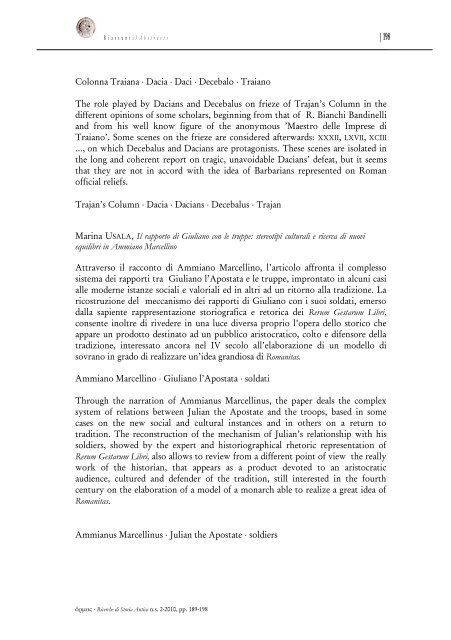n.s. 2-2010 - Societa italiana di storia militare
n.s. 2-2010 - Societa italiana di storia militare
n.s. 2-2010 - Societa italiana di storia militare
You also want an ePaper? Increase the reach of your titles
YUMPU automatically turns print PDFs into web optimized ePapers that Google loves.
R i a s s u n t i / A b s t r a c t s | 198<br />
Colonna Traiana Dacia Daci Decebalo Traiano<br />
The role played by Dacians and Decebalus on frieze of Trajan’s Column in the<br />
<strong>di</strong>fferent opinions of some scholars, beginning from that of R. Bianchi Ban<strong>di</strong>nelli<br />
and from his well know figure of the anonymous ’Maestro delle Imprese <strong>di</strong><br />
Traiano’. Some scenes on the frieze are considered afterwards: XXXII, LXVII, XCIII<br />
…, on which Decebalus and Dacians are protagonists. These scenes are isolated in<br />
the long and coherent report on tragic, unavoidable Dacians’ defeat, but it seems<br />
that they are not in accord with the idea of Barbarians represented on Roman<br />
official reliefs.<br />
Trajan’s Column Dacia Dacians Decebalus Trajan<br />
Marina USALA, Il rapporto <strong>di</strong> Giuliano con le truppe: stereotipi culturali e ricerca <strong>di</strong> nuovi<br />
equilibri in Ammiano Marcellino<br />
Attraverso il racconto <strong>di</strong> Ammiano Marcellino, l’articolo affronta il complesso<br />
sistema dei rapporti tra Giuliano l’Apostata e le truppe, improntato in alcuni casi<br />
alle moderne istanze sociali e valoriali ed in altri ad un ritorno alla tra<strong>di</strong>zione. La<br />
ricostruzione del meccanismo dei rapporti <strong>di</strong> Giuliano con i suoi soldati, emerso<br />
dalla sapiente rappresentazione storiografica e retorica dei Rerum Gestarum Libri,<br />
consente inoltre <strong>di</strong> rivedere in una luce <strong>di</strong>versa proprio l’opera dello storico che<br />
appare un prodotto destinato ad un pubblico aristocratico, colto e <strong>di</strong>fensore della<br />
tra<strong>di</strong>zione, interessato ancora nel IV secolo all’elaborazione <strong>di</strong> un modello <strong>di</strong><br />
sovrano in grado <strong>di</strong> realizzare un’idea gran<strong>di</strong>osa <strong>di</strong> Romanitas.<br />
Ammiano Marcellino Giuliano l’Apostata soldati<br />
Through the narration of Ammianus Marcellinus, the paper deals the complex<br />
system of relations between Julian the Apostate and the troops, based in some<br />
cases on the new social and cultural instances and in others on a return to<br />
tra<strong>di</strong>tion. The reconstruction of the mechanism of Julian’s relationship with his<br />
sol<strong>di</strong>ers, showed by the expert and historiographical rhetoric representation of<br />
Rerum Gestarum Libri, also allows to review from a <strong>di</strong>fferent point of view the really<br />
work of the hi<strong>storia</strong>n, that appears as a product devoted to an aristocratic<br />
au<strong>di</strong>ence, cultured and defender of the tra<strong>di</strong>tion, still interested in the fourth<br />
century on the elaboration of a model of a monarch able to realize a great idea of<br />
Romanitas.<br />
Ammianus Marcellinus Julian the Apostate sol<strong>di</strong>ers<br />
ὅρμος - Ricerche <strong>di</strong> Storia Antica n.s. 2-<strong>2010</strong>, pp. 189-198

















